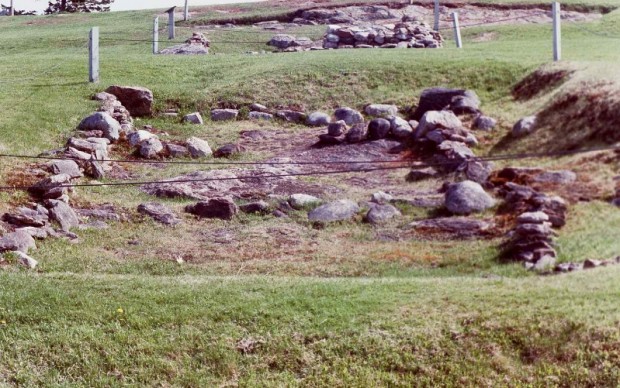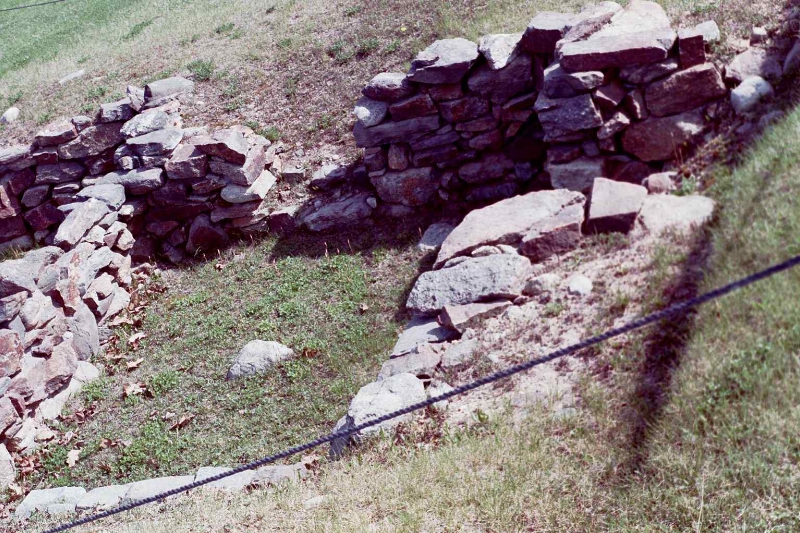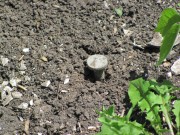Outline of a Building at Pemaquid (2001)
The views of digs at shell middens above, often a target of archaeologists, provide a view of prehistoric archeological research.
in Maine focuses on two general classes of archaeological sites, based upon their origin. Native Americans created the “prehistoric” archaeological record, and the European Americans created the “historic” archaeological record. This article was adapted from a publication of the Maine Historic Preservation Commission
Prehistoric Archaeology
Maine’s Native Americans left no written records, indeed few lasting records of any kind, before the arrival of Europeans. European explorers in the sixteenth century wrote the first historic record of them, so we refer to the archaeology of Maine’s Native American inhabitants as “prehistoric” archaeology.
The first Native Americans to live in Maine moved from the south or the west about 11,000 years ago. Then the land was recovering from its glaciation, and tundra and open spruce woodland vegetation grew enough to support the large and small game that they hunted (including mastodon and caribou). We call these people Paleo-Indian.
Because of poorly developed late glacial drainage, and perhaps because of major seasonal runoff and occasional catastrophic drainage of huge interior lake basins dammed by ice or glacial till, these people tended to camp on very well drained (sandy) soils away from river valleys.
Between 10,500 and 9,500 years ago, trees (pine, poplar, birch, and oak, with other hardwoods later) covered the Maine landscape, forcing everyone who has resided here since to live and travel along lakes and waterways and otherwise adapt to a dense forest. One example is the proliferation of stone axes and gouges during the Archaic Period (between 10,000 and 3000 years ago), indicating exquisite skill in woodworking, examples of which have not survived in Maine’s acidic soil.
Until 4000 years ago, we have reason to believe that people traveled in dugout canoes on the ocean, on rivers, and on major lakes. Dependence on heavy dugout canoes to some degree limited mobility. Sometime between 4000 and 3500 years ago, the birch bark canoe was developed. Use of such light, back-portable watercraft allowed travel up and down small streams and beaver-flowages, as well as cross-drainage portaging. The birch bark canoe opened up the Maine interior away from major lakes and rivers.
The Ceramic Period in Maine (1000 B.C. to A.D. 1500) is so-named because the state’s Native Americans adopted the use of pottery. Pottery with exterior designs increased the number and stylistic detail of artifacts that we can use to understand the archaeological record. After the first European explorers arrived off the Maine coast in the early 1500s and began trading (the so-called Contact Period), dramatic changes in Native American life occurred, and European written records began.
For most of prehistory, Maine’s Native American population supported itself by hunting, fishing, and gathering in band-organized societies without complex political organization or monumental construction. In southwestern Maine, corn, bean, and squash agriculture was added to an existing hunting and gathering base after about 1000 A.D. without drastic change in socio-political organization and with only subtle changes in the use of the landscape. Maine Native Americans always have been relatively mobile in lifestyle and lived in small groups. The largest and most prominent occupations were multi-seasonal villages of several hundred individuals, from which most of the population would disperse over the landscape at certain seasons.
Thus, in the absence of monumental architecture or permanent villages and towns, we recognize four types of prehistoric archaeological sites: (1) habitation/workshop sites, (2) lithic (stone raw material) quarries, (3) cemeteries, and (4) rock art petroglyphs and pictographs.
Ninety-five percent or more of known prehistoric habitation or workshop sites in Maine are located adjacent to canoe-navigable water (coast, lake, river, stream, swamp) or “fossil” (former) waterways or shorelines of the same types. Shell middens, or heaps, are evidence of prehistoric activity.
Of the remainder, approximately one percent are predictable on highly specialized locations, such as eolian (windblown or dune) sands in the case of Paleo-Indian sites, or tillable, alluvial (river flood sediment) soils in the case of Late Woodland and Early Contact period sites.
One prehistoric camp site has been discovered and excavated on the shore of Aziscohos Lake in Oxford County. The lake’s water level is affected by the Aziscohos Dam at the head of the Magalloway River.
The “Palaeo-American encampment” site was named for its discoverer, Alexandra Morss. The ancient (“palaeo”) site “now occupies an exposed point completely at the mercy of pounding waves and drifting ice clocks,” according to R.M. Gramly who has excavated and reported on it.
The Morss site was apparently selected by its ancient inhabitants for its access to a killing ground where migrating caribou could be intercepted and hunted for their meat for food, bones for tool-making, and fur for clothing. People probably visited this and nearby encampments seasonally, processed the carcasses, and refurbished their arrowheads, spear points, and scraping implements, many of which were found during the excavations.
According to Gramly, the evidence suggests that the Morss site was used in the spring, while the nearby Vail and Adkins sites, which had similar but larger hunting implements, were fall encampments where the caribou harvested had thicker fur and harder bones.
Habitation/workshop sites are found in two major depth categories in Maine: shallowly buried and deeply buried. The majority are shallowly buried on soils derived from glacial till, reworked till, sand, gravel, and silt emplaced by geological processes before 12,000 years ago. In these situations there has been no net accretion of the land surface except by human action, and archaeological matter is found within the top 30 to 40 cm of active soil turnover (by frost and plant growth) on these types of soils. In these situations, which represent more than ninety-five percent of the land surface of Maine, archaeological material is shallowly buried and can still be discovered or destroyed by any process that disturbs the top 40 cm or so of the soil column.
Deeply buried sites occur only in alluvial settings along rivers and streams, where periodic flooding has deposited silt or sand which separates sequential occupations. Such sites can be up to three meters deep. The maximum dimension (length) of archaeological sites range from two meters to 800 meters. The modal average maximum dimension falls around 50 meters.
Historic Archaeology
 In 1976 the Maine Historic Preservation Commission began to address archaeological sites of the historic period, complementing the survey programs for prehistoric sites and architectural resources.
In 1976 the Maine Historic Preservation Commission began to address archaeological sites of the historic period, complementing the survey programs for prehistoric sites and architectural resources.
One of the first actions in 1976 was to establish survey priorities for the new science of historic archaeology in Maine. The cornerstone of the initiative was the decision that sites of the early colonial period should be the primary focus for identification, evaluation, and protection. This period is subdivided into three phases: Early settlement (1604-1675) , Indian Wars (1676 to early eighteenth century), and Resettlement Period (early to mid-eighteenth century). Simply stated, these sites, such as the Popham Colony and Pemaquid, were recognized as the scarcest, least documented, and most prone to destruction by vandalism, development, and erosion in that they are almost exclusively found on navigable water, either estuarine or marine.
On a secondary level, other sites were also recognized as deserving attention. The Commission determined that sites representing the earliest penetration of European Americans into a given area, regardless of period, are worthy of attention, given their poor documentation, their vulnerability to subsequent expansion of communities, and their data regarding adaptation of new populations to wilderness areas. In addition, sites relating to important Maine events or industries are recognized as important priorities.
By and large the Commission’s principal efforts have addressed the traces of earliest European impact on the Maine landscape.
Additional resources
Baker, Emerson W. The Clarke & Lake Company: the Historical Archaeology of a Seventeenth-Century Maine Settlement. Augusta, Me. Maine Historic Preservation Commission. c1985.
Belcher, William R. Archaeological Investigations at the Knox Site (30-21), East Penobscot Bay, Maine.Orono, Me. 1988. (Thesis (M.S.) in Quaternary Studies–University of Maine, 1988.)
Depaoli, Neill. Beneath theBarracks: Archaeology at Fort Sullivan, a Report on Preliminary Investigations. Eastport, Moose Island, ME. Research Committee, Border Historical Society. 1986.
Gramly, Richard M. “The Morss Fluted Point Site, Northwestern Maine.” The Amateur Archaeologist. Volume 72 (2).
Mack, Karen E. Archaeological Investigations at the Todd Site (17-11), Muscongus Bay, Maine. Orono, Me. 1994. (Thesis (M.S.) in Quaternary Studies–University of Maine, 1994.)
Maine Historic Preservation Commission. Augusta, Maine.
Maine Archaeological Society. P.O. Box 982, Augusta, Maine 04332-0982.
Report of the Commissioners in Charge of the Remains of the Ancient Fortifications at Pemaquid. Augusta, Me. Kennebec Journal Print. 1902. [University of Maine, Raymond H. Fogler Library, Special Collections; Maine State Library; Bangor Public Library]
Smith, Nicholas N. The Challenge of Maine Archaeology. Orono, Me. Maine Archaeological Society, 1964. (A Maine Archaeological Society Publication, vol.1, no.1 (1964, spring issue).
Spiess, Arthur E. and Wilson, Deborah Brush. Michaud, a Paleoindian Site in the New England-Maritimes Region. Augusta, Me. Maine Historic Preservation Commission. Maine Archaeological Society. 1987.
Stanyard, William F. The Moorehead Phase: Mortuary Material Culture and Social Process in Coastally Adapted Peoples of the Gulf of Maine Region between 5,000 and 3,700 B.P. Orono, Me. 1993. (Thesis (M.S.) in Quaternary Studies–University of Maine, 1993.)




